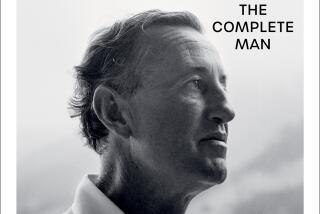Smiley’s model
James Bond may be the prototypical English spy, but more discerning readers know that John Le Carré’s novels come as close as possible to depicting a “true” portrait of the men and women who populate British intelligence. His most indelible creation, George Smiley, is worlds away from Bond: “short, fat and of a quiet disposition . . . [appearing] to spend a lot of money on really bad clothes.” Instead of indulging in international jet-setting and world-saving, Smiley chafes at Byzantine government schemes and covert operations so complicated that a labyrinth wouldn’t do proper pictorial justice.
Without Le Carré, current spymasters such as Robert Littell, Charles McCarry, Stella Rimington and Daniel Silva might not have careers. But Le Carré himself owes his career to a colleague of his own. When the author still toiled in intelligence circles under his real name, David Cornwell, his career overlapped for a time with that of John Bingham, Lord Clanmorris (1908-88).
During a 30-year career of undercover agenting and high-ranking bureaucracy, Bingham wrote 17 novels and a work of nonfiction, sometimes using the pen name Michael Ward. He may be best known, though, as an unwitting inspiration for the fictional composite that would become Smiley, the character who eventually made Le Carré a literary star.
As a result, perhaps, the relationship between Le Carré and Bingham soured. “As far as he was concerned, I was a literary defector who had dragged the good name of the Service through the mud,” Le Carré wrote in a 2000 essay that accompanied last summer’s reissue of three of Bingham’s novels.
It may be tempting to view Bingham’s first two novels -- “My Name Is Michael Sibley” (Simon & Schuster: 258 pp., $13 paper) and “Five Roundabouts of Heaven” (Simon & Schuster: 208 pp., $13 paper) -- as grotesque foreshadowings of the bitter end of his friendship with Le Carré, since both books mine the dark undercurrents of long-standing male relationships. In the first book, the title character has just come back from visiting school chum John Prosser when he gets word of the man’s murder. The police want to question him, but panic sets in, and Sibley reacts by tossing aside “the cool, analytical training learnt in the previous ten years, and lied like a sneak thief caught in compromising circumstances.”
Bingham soon makes clear just how compromising those circumstances are, for the façade of friendship conceals years of petty cruelty inflicted on Sibley by Prosser, and even time can’t quell Sibley’s hate. His pain and thwarted anger make for an unreliable narration so tightly wound that the ending, though somewhat contrived, still comes as a welcome surprise.
And yet, if Sibley narrates unreliably, Peter Harding almost dispenses with likability altogether as the protagonist of “Five Roundabouts.” He is a hotel proprietor not shy about his ambition, so his reunion with old friend Philip Bartels after 19 years allows him the opportunity to perfect skillful manipulation.
Peter dissects the tortured triangle among Bartels, his wife, Beatrice -- a woman who loves but does not believe in falling in love -- and Lorna Dickson, dissecting the hopelessly unequal balance of the trio’s affections. Eventually, Peter’s true hand is revealed. “I was always a better man than Bartels,” he declares, “better at everything, including murder.”
Bingham’s gift, however, is not to give too much weight to this statement, concentrating on Peter’s more astonishing assertion that he regards Bartels “not only as my friend but as one of the most lovable characters I have never known.” Pages of self-explanation could not better exemplify Peter’s inner sociopath than these terse sentences.
First published in 1952 and 1953, these two novels demonstrate Bingham’s ability to combine clever plotting and psychological acuity in a manner reminiscent of Patricia Highsmith. Such factors are even more acute in 1965’s “A Fragment of Fear” (Simon & Schuster: 176 pp., $13 paper), a noose-tightening suspense novel that begins with the murder of an elderly woman in Italy, before descending into a small-scale conspiracy directed at the book’s protagonist, James Compton.
Once again, Bingham gives us an unreliable narrator whose assertions of innocence ring more and more false with every new twist. Yet Bingham also seeds the book with doubt, teasing out plausible explanations for why someone would want to break into Compton’s apartment, use his typewriter to write damning notes and pit him against his future wife’s family -- people he’s supposed to trust.
Common themes permeate Bingham’s works, among them his penchant for writer protagonists (Sibley is a struggling novelist; Compton is more successful). The mores and incidental trappings place these novels firmly in the second half of the 20th century, but Bingham manages to look far ahead of his time, sometimes with startling effect.
This is especially true of “A Fragment of Fear,” which sticks in my mind as much for the propulsive plot as for what Compton believes to be “an accurate picture of the events of that terrible morning of September 11.”
That’s a hell of a coincidence, and it grows even larger when we consider the novel’s opening paragraphs, which discuss how “man has always been stalked by terror” and how we live in a “dangerous age.”
A student of history and human behavior, Bingham creates resonance for our historical moment -- as well as for his own.
Sarah Weinman blogs about crime and mystery fiction at Confessions of an Idiosyncratic Mind ( www.sarahweinman.com). Dark Passages appears monthly at latimes.com/books.
More to Read
Sign up for our L.A. Times Plants newsletter
At the start of each month, get a roundup of upcoming plant-related activities and events in Southern California, along with links to tips and articles you may have missed.
You may occasionally receive promotional content from the Los Angeles Times.






